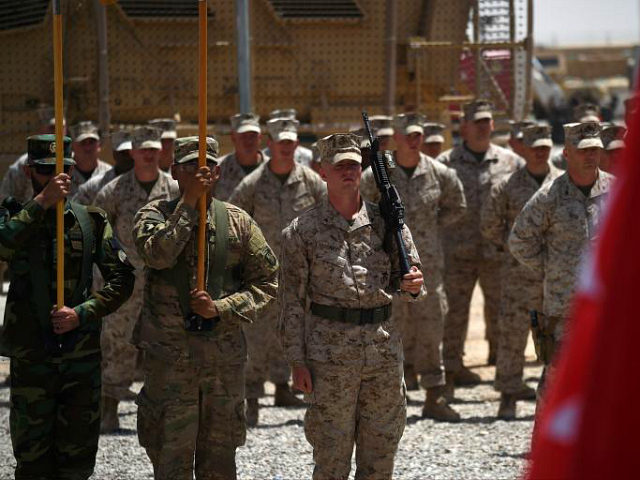An estimated 300 U.S. Marines have been deployed to the Taliban-stronghold Helmand, considered one of the deadliest provinces of the 16-year-old war for the American-led coalition and their Afghan allies.
The deployment marks the return of the U.S. Marines to a province that has largely fallen back into the hands of the Taliban after the Marines spilled significant blood to liberate it from the jihadist group.
“Between October 2010 and March 2011 [height of troop surge], U.S. Marines in [Helmand’s] Sangin District sustained the heaviest losses of any Coalition battalion during the Afghanistan campaign,” notes the Special Inspector General for Afghanistan Reconstruction (SIGAR), a U.S. watchdog agency, in its latest report to Congress.
According to the Washington Post (WaPo), Brig. Gen. Roger B. Turner Jr., the top officer in the Marine task force deployed to Helmand, said of the recent deployment:
We’re still seeing a lot of the same activity that we were seeing years ago from the Taliban. They are still scattering IEDs [improvised explosive devices] everywhere. They still kind of indiscriminately target people. They arrest people, they put them in jails, and they extort their families, and they extort the farmers for their poppy production and tax them… It’s more of the same.”
Helmand is located on the Pakistan border in southern Afghanistan, next to Kandahar province, the birthplace of the Taliban. Helmand has long been considered the most violent province in war-ravaged Afghanistan.
In 2016, the United Nations reported that Helmand remained the top poppy-producing province in Afghanistan, the world’s primary supplier of opium and its heroin derivative.
U.S. Gen. John Nicholson, the top commander of American and NATO troops in Afghanistan, told reporters last December that the Taliban generates most of its funding for terrorist activities from trafficking opium, primarily cultivated in Helmand.
SIGAR reports:
Helmand has strategic importance as one of the two [Kandahar] principal opium-producing regions in Afghanistan… General John W. Nicholson Jr., has characterized the Taliban as a “narco-insurgency” which depends on opium trafficking for 60% of its funding.
Northern Helmand is also home to the Kajaki Dam, which helps provide power to the southern provinces. Helmand borders Kandahar and Uruzgan provinces, as well as Pakistani Baluchistan, from which the Taliban funnels supplies and fighters across the southern desert into the Helmand River Valley.
The U.S. has deployed the estimated 300 Marines as a unit dubbed Task Force Southwest.
Former President Barack Obama approved sending them to southern Afghanistan to train, advise, and assist the Afghan National Defense and Security Forces (ANDSF) struggling to push the Taliban out of Helmand.
However, their mission may change contingent upon policy decisions that President Donald Trump makes for the ongoing war in Afghanistan, which started in October 2001.
The Trump administration is considering a plan to increase America’s military footprint in the country by at least 3,000 forces to assist the ANDSF, which according to SIGAR has suffered a “shockingly high” number of casualties, primarily at the hands of the Taliban.
Army Lt. Gen. H.R. McMaster, the president’s national security adviser, and the Pentagon are reportedly behind the plan to expand America’s involvement in Afghanistan, boosting the estimated 8,300 U.S. troops already serving in Afghanistan.
This year, Gen. Nicholson told U.S. lawmakers he was facing a shortfall of a “few thousand” troops to help the ANDSF, which includes military and police units, break a years-long “stalemate” in Afghanistan, noting that it does not matter if the additional troops come from the United States or other members of NATO.
The Post recently reported that President Trump is expected to make a decision on sending additional American troops to Afghanistan this month.
Asked whether or not additional troops would be helpful, Marine Gen. Turner told the Post that his unit has enough “capabilities, capacities and authorities” now but that if the Trump administration expands the mission, “then we’re not going to have enough to do what we need to do.”
“His terminology describes not only the number of troops his unit has but the kinds of operations they are trained to do and what rules they must follow,” notes the WaPo, later adding:
Turner said that he has found that there are places where Afghan brigades are already capable and that adding U.S. advisers to the mix actually would be “step backwards.” In other places, he said, it could be helpful. He cited issues such as paying soldiers and maintaining vehicles, both of which require coordination with the central government.
SIGAR told Congress that 64 percent (nine of 14 districts) of Helmand province is under the control or influence of the Taliban.
The inspector general notes that provinces along the Pakistan border, primarily Helmand and Kandahar, are home to the most territory under insurgent control or influence.
On April 29, the newly deployed Marine unit replaced an Army component known as Task Force Forge, reports the Post.
“The new mission returns Marines to a part of Afghanistan where more than 20,000 were based in 2010 and 2011 at the height of a troop surge that included more than 100,000 U.S. troops across the country,” the newspaper continues.
SIGAR recently predicted that the security situation would continue to deteriorate in Afghanistan.
The Marines’ “deep experience” in Helmand will provide “a more structured advisory effort than [U.S. Forces have] had up to this point,” declared Gen. Nicholson.
The U.S. Marines have been deployed to assist the embattled Afghan National Army’s 215th Corps in Helmand.
According to various assessments, Taliban jihadists control more territory now than during any other time since they were removed from power by the U.S. military in 2001.
At least 2,251 American troops have been killed and another 20,218 wounded in action during the ongoing war in Afghanistan, reports the Pentagon.

COMMENTS
Please let us know if you're having issues with commenting.